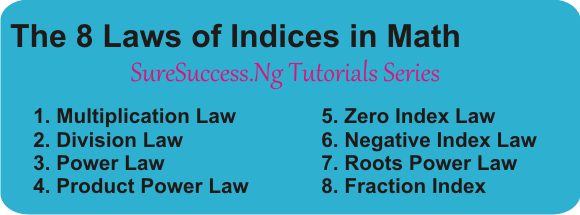You are very welcome to the Mathematics tutorials section of your favorite website, www.suresuccess.ng. On this post, I will teach you Index notations. You will also learn the laws that govern index notations which are generally referred to as the Laws of Indices in Mathematics. So whether you are preparing for Math in WAEC, NECO, JAMB, GCSE or iGCSE, you will learn everything you need to excel in questions drawn from indices.

Table of Contents
What are Indices?
The word, “indices” is the plural of index. So in order to fully understand the meaning of indices, we need to understand what index is all about.
An index is a number, usually written as a superscript, that shows the number of times a term has been multiplied by itself.
Below is an example of a term written using the index notation:
54
Here, 5 is the base while 4 is the index or power.
We can read this as ‘4 to the power 3’
We can also express 54 in an expanded form as:
5 × 5 × 5 × 5 = 625
In other words, index notations is a way of shortening the product of numbers of equal factors or numbers that are the same.
Below are other examples:
- 2 x 2 x 2 x 2 x 2 = 25 [where 2 is the base and 5 is the power or index]
- 7 x 7 x 7 x 7 x 7 x 7 = 76 [where 7 is the base and 6 is the power or index]
Therefore, as a general rule of index notation, if we have a x a x a x a =a4, the “a” is called the base while 4 is the power or index.
Read Also: Is Maths Compulsory for Accounting in JAMB
Key Mathematical Concepts

The following are the key Math concepts we can draw so far:
- Index of a Number: The index of a number shows the number of times a term (or number) is to be multiplied by itself. It usually written as a superscript i.e. a smaller number to the right and above the base. The index of a number is also called power or exponent.
- Base of a Number: The base is the number that is raised to a power or index. In other words, it is the number that we multiply using the index or power.
It is very important to understand and get really familiar with the two key concepts above. They are foundational to learning the laws of indices. So you must do well to grasp the concepts.
Solving Calculations with Indices (Use of the Laws of Indices in Mathematics)
There are a variety of different calculations involving indices that you may meet in your test or examination. In order to calculate them very well and ace your test or exam, you must be acquainted with the laws that govern Indices. These laws help you to manipulate mathematical problems accurately.
Let’s look at the different laws of indices in Mathematics.
Laws of Indices in Mathematics
The laws of Indices are the rules or principles guiding the simplification of mathematical expressions or equations involving powers of the same base.
For example, we can apply the laws of indices to solve 42 x 43 = 45 because the bases are the same (i.e. 4).
This implies that we cannot safely use the laws of indices to tackle problems involving powers of different bases. For example, we cannot solve the problems 34 ÷ 53 and 32 x 43 using the laws of indices because the bases are not the same. However, we can still evaluate the problems using other means.
The 8 Laws of Indices in Mathematics
The following are the eight laws that govern simplification of mathematical expressions involving indices.
1. Multiplication Law (ax x ay = ax + y)
When numbers with equal bases are multiplied, their powers (indices) are added.
For example:
32 x 35 = (3 x 3) x (3 x 3 x 3 x 3 x 3) = 32 + 5 = 37.
Hence the multiplication law of indices: ax x ay = ax + y.
But if we are multiplying two groups of factors (i.e. different numbers), we collect the different factors as one group to give the product.
For example:
25 x 32 x 23 x 34 = 25 x 23 x 32 x 34 = 25 + 3 x 32 + 4 = 28 x 36.
2. Division Law (ax ÷ ay = ax – y)
When dividing numbers with equal bases; subtract the power of the divisor from that of the dividend.
For example:
29 ÷ 26 = (2 x 2 x 2 x 2 x 2 x 2 x 2 x 2) ÷ (2 x 2 x 2 x 2 x 2 x 2) = 28 i.e. 29 – 6
In general, the division law of indices: ax ÷ ay = ax – y.
3. Power Law [(ax)y = axy]
If a number which is raised to a certain power is again raised to another power, we say that the number is in powers.
In this case, to get an instant result, we multiply the two powers together.
For example: (23)2 = 23 x 23.
Applying the multiplication law, we have 23 x 23 = 23 +3 = 26.
Therefore, (23)2 = 22 x 3 = 26 as before.
Generally, the power law of indices: (ax)y = axy.
4. Product Power Law [(ab)x = axbx]
When the product of different factors are raised to a certain power, perhaps in a bracket, the power is distributed over each factor in the bracket.
For example:
(3pq)2 = 32 x p2 x q2 = 9p2q2
Generally, the product power law: (ab)x = axbx.
5. Zero Index Law (x0 = 1)
When any number or quantity is raised to power zero, the result is 1.
We can demonstrate this using the 2nd Law of Indices i.e. the division law.
23 ÷ 23 = 23 – 3 = 20.
But obviously 23 ÷ 23 = 23⁄23 = (2 x 2 x 2)⁄(2 x 2 x 2) = 1
Therefore, 20 = 1 from the demonstration above.
Similarly:
a0 = 1
x0 = 1
50 = 1
10000 = 1
and so on.
6. Negative Index Law
Indices are not always positive. They can also be negative. This means that a number can be raised to a negative index.
The rule is that a number raised to a negative index equals the reciprocal raised to the same positive index.
Let me quickly do the demonstration for you.
According to the division law of indices, 26 ÷ 29 = 26 – 9 = 2–3
Obviously 26 ÷ 29 = (2 x 2 x 2 x 2 x 2 x 2)⁄(2 x 2 x 2 x 2 x 2 x 2 x 2 x 2 x 2) = 1⁄23
Therefore 2-3 = 1⁄23 .
Similarly,
- a-3 = 1⁄a3 .
- 3-2 = 1⁄32 = 1⁄9 .
- 5-4 = 1⁄54 = 1⁄625 .
and so on.
7. Roots Power Law
The roots power law of indices involves the method of showing the indices for different roots line square root, cube root, fourth root, and so on.
(a) consider 21⁄2
If we have 21⁄2 x 21⁄2,
Then according to multiplication law, 21⁄2 x 21⁄2 = 21⁄2 + 1⁄2 = 21 =2.
It shows that 21⁄2 = √2 i.e. square root of 2.
Similarly, if we have 91⁄2, then 91⁄2 = √9 = 3.
Hence, a1⁄2 = √a
(b) consider 21⁄3
If we have 21⁄3 x 21⁄3 x 21⁄3
Then according to multiplication law, 21⁄3 x 21⁄3 x 21⁄3 = 21⁄3 + 1⁄3 + 1⁄3 = 21 =2.
From the second demonstration above, we see that any number raised to power one-third i.e. 1⁄3 means the cube root of the number.
Hence, a1⁄2 = √a
Therefore, generally speaking a1⁄m = m√a i.e. the nth root of the number.
8. Fraction Index
This law applies to the case where a number is raised to a power which is a fraction other than half.
You can solve this by finding the value root (nth root) of the denominator and raise the outcome to the power of the numerator.
Generally, the fraction index law of indices: am⁄n = (n√a)m
For example, consider 43⁄2
Since the power is 3/2, we first find the square root of 4 (because 2 is the denominator of the fraction index). Thereafter, we raise the outcome to power 3 (because 3 is the numerator of the fraction index).
Solving that, we have 43⁄2 = (√4)3 = 23 = 8
That’s all there is to the Laws of Indices in Mathematics.
Read Also: Compulsory Subjects for Law in JAMB and WAEC
Conclusion
So here’s where we end this very comprehensive tutorials on the Laws of Indices in Mathematics. I trust that it is helpful.
The eight laws of indices are easy to understand and remember. Adequate understanding of the laws of indices is key to manipulating or simplifying mathematical expressions involving indices. You also need to be familiar with the laws of indices if you must evaluate mathematical expressions involving indices without calculators.
If you need to, you can go over the tutorial again to ensure that you understand it. But in case there’s something you don’t understand, you can use the comments section to ask questions. Otherwise, just share your thoughts with me; I’d love to hear from you. Remember that math is a compulsory subject in WAEC and NECO.
Kindly help us to reach others with this tutorial. Share with friends on Social Media. Just scroll down to see the Facebook and Twitter and WhatsApp buttons. Thank you so much!
See you on the next tutorial.
Still Got a Question? Drop Your Question Right HERE 👇👇 and click on Search. Get an Immediate Response...
Get in touch with us
Join our FREE 2026 JAMB, WAEC, NECO and BECE Tutorial Classes here: Youtube (Subscribe to the channel)
This is for JSCE, Science and Art Students
If this post was helpful to you, please help us to reach others by sharing with the buttons below!